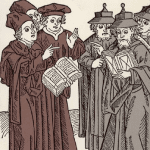Unraveling the Intricacies of Christopher Nolan’s Oppenheimer: A Profound Cinematic Adaptation
Exploring Nolan’s Oppenheimer
Christopher Nolan’s Oppenheimer demonstrates the complexities of relationships by illuminating the depths and depravity that come with human ingenuity, power, and responsibility. Based on the Pulitzer prize-winning biography “American Prometheus; The Triumph and Tragedy of J. Robert Oppenheimer” by Kai Bird and Martin J. Sherwood, Nolan’s cinematic adaptation documents the life and quick ascent of the man often considered as his country’s greatest theoretical physicist. Nolan’s creation is intense, and in many respects, rather Jewish.
Oppenheimer: A Character Study
Oppenheimer expresses concern over the tyranny stemming from Hitler’s Europe through the lens of his Jewish identity, lamenting not only the loss of life but the Jews that, at the time, lingered in the balance. Nolan’s Oppenheimer is by all accounts brilliant, trepidatious about his talents, preferring accuracy and anonymity over fame and celebrity. There’s a clear emphasis on getting it right over being remembered.
The Father of the Atom Bomb
Known as the Father of the Atom Bomb, the Jew responsible for creating it can’t help but bleed extreme caution. Motivated by both his own morals as well as those of his colleagues, such as Isidor Isaac Rabi, Oppenheimer’s goals become complicated and multifold. Success at Los Alamos comes at a price that he knows will ultimately be paid long after his expiration date.
The Security Hearings
Nolan grounds the film in the present, anchoring the story through the lens of his 1954 security hearings before the United States Atomic Energy Commission, over a security clearance that was delayed upon reception and denied upon renewal. Nolan could have stopped after a standard two hours, shortly after both bombs are dropped, with Oppenheimer’s face hitting the cover of Time and his disappointing meeting with President Truman in the Oval.
Interrogating the Past
But the past needs to catch up with the present and Oppenheimer’s ties to the American Communist Party, prompting accusations of disloyalty and ideological compromise at Los Alamos, must be thoroughly scrutinized. While we are given glimpses of his headaches, the best scenes are found in the process, where rich debate over technical mathematics, fission v. fusion, and competing egos captivates each and every sold-out crowd.
The Transformation of Oppenheimer
However, it isn’t until the end that Oppenheimer is seen in a new light, venerated by all except himself, only this time he’s praised like a politician and not a scientist. This culminates in cheers, the American flag blowing in the background. And all of a sudden Oppenheimer’s alleged communist past is traded in for his patriotic present.
Meetings with Albert Einstein
His meetings with Albert Einstein serve as a testament to his character. Perhaps it’s fitting that of all the Einsteins that choose to participate Einstein himself chose to pass. The hesitation to embrace an atomic future is understood as, if not entirely Jewish than certainly one embraced by Jews. This Nolan makes clear.
The Weight of His Actions
His makeshift victory speech after both bombs are dropped can’t be delivered without his wish that they be dropped 2 years earlier on Germany, the fate of his people forever on his mind. While not held before a court, the 1954 security hearings presented Oppenheimer as a man on trial for ideological reasons when in reality it appeared that he put himself on trial for moral ones.
The Irony of the Atomic Energy Commission
Ironically though, the Atomic Energy Commission is obsessed not with the 6 figure death tolls in Asia but with his ideological alliances at home and abroad. The Soviets are an ally only in relation to the Axis, not in relation to the United States.
The Forecast of the Arms Race
If Oppenheimer makes anything clear, it is that the arms race preceded the existence of such arms, a forecasting that he himself saw from the get-go. Ultimately, Oppenheimer demonstrates the evolution from abstract theory to pragmatic reality, drawing a linear relationship between the blackboard and the battlefield.
Oppenheimer’s Concerns for the Future
While the government remained concerned about Oppenheimer’s past, he was concerned with America’s present and a future which continues to share his concerns.












